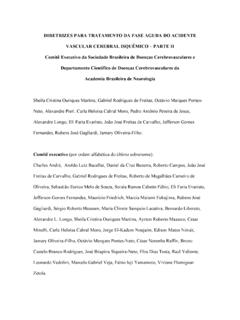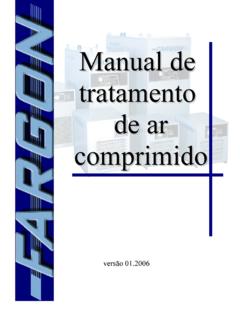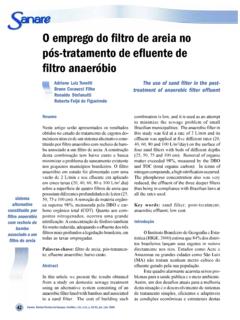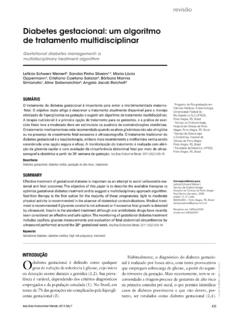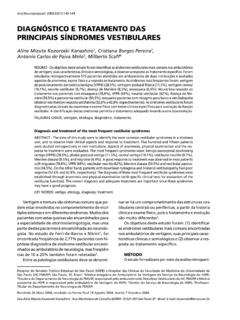Transcription of Guidelines for acute ischemic stroke treatment – Part I
1 Guidelines . Guidelines for acute ischemic stroke treatment Part I. Diretrizes para tratamento do acidente vascular isqu mico Parte I. Executive Committee from Brazilian stroke Society and the Scientific Department in Cerebrovascular Diseases of the Brazilian Academy of Neurology and the Jamary Oliveira-Filho, Sheila Cristina Ouriques Martins, Oct vio Marques Pontes-Neto, Alexandre Longo, Eli Faria Evaristo, Jo o Jos Freitas de Carvalho, Jefferson Gomes Fernandes, Viviane Flumignan Z tola, Rubens Jos Gagliardi, Leonardo Vedolin, Gabriel Rodr guez de Freitas These Guidelines are a result of several meetings from 3. RCT with substitute, non-validated endpoints case-con- the Brazilian stroke Society (Sociedade Brasileira de trol studies.)
2 Doen as Cerebrovasculares SBDCV, website 4. Study with clinical endpoint, but with a higher potential ), which represents the Scientific Department bias (as in experiment without comparison group and in cerebrovascular diseases of the Brazilian Academy of other observational studies). Neurology, responsible for technical opinions and edu- 5. Representative forum or expert opinion without above- cational projects related to cerebrovascular diseases. mentioned evidence. Members from SBDCV participated in web-based discus- sion forum with pre-defined themes, followed by a formal onsite meeting in which controversies and final position RECOMMENDATION GRADES. statements were discussed. Finally, a writing group was created to revise and translate the final document, which A Systematic review (homogeneous) of RCT; or single RCT.
3 Was approved by all members of the SBDCV. The final text with narrow confidence interval; or therapeutic results of aims to guide specialists and non-specialists in stroke care all or nothing type. in managing patients with acute ischemic stroke . The B Systematic review (homogeneous) of cohort studies; or hemorrhagic stroke guideline has been previously pub- cohort study and RCT of lower quality; or outcomes re- lished by the same group1. In the final recommendations, search or ecological study; or systematic review (homoge- Oxford classification for evidence level and recommenda- neous) of case-control studies; or case-control study. tion grade was used: C Case reports (including cohort or case-control study of lower quality).
4 D Expert opinion without critical evaluation, based on phys- EVIDENCE LEVELS iological or animal studies. 1. Randomized controlled clinical trial (RCT) or systematic In this first part of the Guidelines , specific topics includ- review (SR) of RCT with clinical endpoints. ed were: epidemiology, stroke as a medical emergency, edu- 2. RCT or SR of lower quality: with substitute, validated end- cation, pre-hospital management, emergency management, points; with subgroup analysis or with a posteriori hypoth- neuroimaging and laboratory evaluation. A translated version eses; with clinical endpoints, but with methodological of these Guidelines in Portuguese is available in the Society's flaws. webpage ( ). Executive Committee: Charles Andr , Aroldo Luiz Bacellar, Daniel da Cruz Bezerra, Roberto Campos, Jo o Jos Freitas de Carvalho, Gabriel Rodrigues de Freitas, Roberto de Magalh es Carneiro de Oliveira, Sebasti o Eurico Melo de Souza, Soraia Ramos Cabette F bio, Eli Faria Evaristo, Jefferson Gomes Fernandes, Maur cio Friedrich, Marcia Maiumi Fukujima, Rubens Jos Gagliardi, S rgio Roberto Haussen, Maria Clinete Sampaio Lacativa, Bernardo Liberato, Alexandre L.
5 Longo, Sheila Cristina Ouriques Martins, Ayrton Roberto Massaro, Cesar Minelli, Carla Helo sa Cabral Moro, Jorge El-Kadum Noujaim, Edison Matos N vak, Jamary Oliveira-Filho, Oct vio Marques Pontes-Neto, C sar Noronha Raffin, Bruno Castelo Branco Rodrigues, Jos Ibiapina Siqueira-Neto, Elza Dias Tosta, Raul Valiente, Leonardo Vedolim, Marcelo Gabriel Veja, Leonardo Vedolin, F bio Iuji Yamamoto, Viviane Flumignan Z tola. Correspondence: Jamary Oliveira-Filho; Rua Reitor Miguel Calmon s/n; Instituto de Ci ncias da Sa de / sala 455; 40110-100 Salvador BA - Brasil; E-mail: Conflict of interest: There is no conflict of interest to declare. Received 18 February 2012; Received in final form 22 February 2012; Accepted 29 February 2012.
6 621. EPIDEMIOLOGICAL ASPECTS communication between health professionals and early ac- cess to neuroimaging. Among the 58 million deaths per year worldwide, mil- The causes of delay in pre-hospital care include the lack of lion were caused by stroke . Therefore, stroke was the sec- knowledge of stroke warning signs, denial of disease state and ond most common cause of death, responsible for 10% of all the hope of spontaneous resolution of symptoms. Educational deaths in world2. However, the global distribution is hetero- initiatives should target patients at risk, as well as their family geneous, as 85% of deaths occurred among developing coun- members. Considering that approximately 45-48% of patients tries and one-third affected economically active individu- are referred by a general clinician, educational campaigns als2,3.
7 This impact is expected to increase in the next decades, should also be directed towards the medical community, em- as projected by a 300% increase in the elderly population of phasizing the importance of emergency treatment13. developing countries in the next 30 years, specially in Latin Eight non-randomized studies evaluated the impact of America and Asia4. educational measures on health care of the stroke victim;. In Brazil, stroke was responsible, in 2005, for 10% of they demonstrated that thrombolysis rate increased after all deaths (90,006 deaths) and for 10% of all public hospi- the educational campaign, but only during six months. This tal admissions4,5. In that year, Brazil spent 2,7 billion dol- shows that an educational intervention requires periodic re- lars in health care on cardiac diseases, stroke and diabetes cycling in order to maintain a positive result14-21.
8 Mellitus4,5. In Latin America, stroke incidence rates adjusted for age Recommendations vary between 35 and 183 per 100,0006, and, in Brazil, vary be- Periodical educational programs to increase stroke tween 137 and 168 per 100,000 inhabitants7-9. In two recent awareness in the general population are recommended (level studies of stroke -related mortality, a steady drop in mortal- of evidence: 1, recommendation grade: B). ity rates were observed in the last two decades10,11. Although Periodical educational programs to increase stroke the reasons for this drop are unknown, classically mortality awareness among medical professionals, other health profes- rates are directly related to changes in incidence or lethality sionals and emergency services are recommended (level of rates11.)
9 Incidence rates are influenced by socio-economical evidence: 1, recommendation grade: B). conditions and quality of primary prevention, while lethality is dependent on disease severity of the sample and quality of hospital care11. Any combination of these factors may have PRE-HOSPITAL CARE AND TRANSPORTATION. improved in Brazil during this time period. stroke is a medical and eventually surgical emergency. After time-dependent therapies have demonstrated to be stroke : A MEDICAL EMERGENCY successful; acute stroke management is tightly linked to this concept of emergency care. However, only a minority of pa- The concept of stroke as a medical emergency is still not tients arrive at emergency rooms on time to benefit from re- well established in Brazil.
10 In a recent study performed in four perfusion therapies for the region affected by ischemia or for Brazilian cities, with 814 individuals, 28 different names were control of intracerebral hemorrhage22-23. This delay is due to a given for stroke12. Only 35% knew that 192 was the appro- series of factors, including lack of knowledge of stroke warn- priate emergency number in Brazil, 22% did not recognize ing signs to underutilization of specialized rescue services, any stroke warning sign, and only 51% would call for emer- as the Servi o de Atendimento M vel de Urg ncia SAMU. gency rescue if a family member had symptoms of stroke . (Mobile Emergency Service) in Brazil12,20,24-26. Many stud- Studies on recognition and activation of emergency ser- ies have demonstrated that utilization of private vehicles or vices performed in developed countries have systematically previous contact with a primary care physician increase the concluded that interventions are necessary to increase the time between stroke onset and hospital admission, often de- number of patients eligible for acute stroke treatment , such laying or contraindicating reperfusion therapy27-31.
